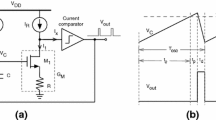Abstract
A low-power relaxation oscillator with a high frequency stability is presented for radio frequency identification (RFID). This oscillator implements an improved self-biased and a comparator multiplexing techniques to reduce the power consumption and chip area. A capacitor resetting delay cancellation technique based on a two-phase operation and a proportional to absolute temperature (PTAT) current with an upward curvature versus the temperature are adopted to maintain the frequency stability. The oscillator is designed in a 65 nm standard CMOS process and occupies a small area of 0.0216 mm2. The post-layout simulation results show that a frequency drift of 0.95% from 0.7 to 1.7 V and a temperature stability of 27 ppm/°C as the temperature varies from − 40 to 85 °C at a typical working frequency of 1.92 MHz. Under a supply voltage of 0.7 V, the maximum power consumption is only 15.4 μW at − 40 °C. At room temperature, the figure of merit (FOM1 and FOM2) are 8 nW/kHz and 89.5 dB, respectively, which makes it more efficient than relaxation oscillators reported to date.








Similar content being viewed by others
References
Want, R. (2006). An introduction to RFID technology. IEEE Pervasive Computing, 5(1), 25–33.
Sun, M., Al-Sarawi, S. F., Ashenden, P., Cavaiuolo, M., & Ranasinghe, D. C. (2017). A fully integrated hybrid power management unit for passive UHF RFID in 130-nm process. IEEE Journal of Radio Frequency Identification, 1(1), 90–99.
EPC Class 1 Generation 2 UHF air interface protocol standard version 2.0.1 [Online]. https://www.gs1.org/epcrfid/epc-rfid-uhf-air-interface-protocol/2-0-1. Accessed Jan 2018.
Yoon, D., Sylvester, D., & Blaauw, D. (2012). A 5.58 nW 32.768 kHz DLL-assisted XO for real-time clocks in wireless sensing applications. In 2012 IEEE international solid-state circuits conference (pp. 366–368).
Kamalinejad, P., Keikhosravy, K., Molavi, R., Mirabbasi, S., & Leung, V. C. M. (2014). An ultra-low-power CMOS voltage-controlled ring oscillator for passive RFID tags. In 2014 IEEE 12th international new circuits and systems conference (NEWCAS) (pp. 456–459).
Flynn, M. P., & Lidholm, S. U. (1992). A 1.2-μm CMOS current-controlled oscillator. IEEE Journal of Solid-State Circuits, 27(7), 982–987.
He, L., Li, G., & Tang, M. (2015). Relaxation oscillator exploiting PTAT hysteresis of differential schmitt trigger. Journal of Circuits Systems & Computers, 24(10), 15501471-1–15501471-9.
Choi, M., Jang, T., Bang, S., Shi, Y., Blaauw, D., & Sylvester, D. (2016). A 110 nW Resistive frequency locked on-chip oscillator with 34.3 ppm/°C temperature stability for system-on-chip designs. IEEE Journal of Solid-State Circuits, 51(9), 2106–2118.
Wang, J., Goh, W. L., Liu, X., & Zhou, J. (2016). A 12.77-MHz 31 ppm/°C on-chip RC relaxation oscillator with digital compensation technique. IEEE Transactions on Circuits and Systems I: Regular Papers, 63(11), 1816–1824.
Chiang, Y. H., & Liu, S. I. (2014). Nanopower CMOS relaxation oscillators with sub-100 ppm/°C temperature coefficient. IEEE Transactions on Circuits and Systems II: Express Briefs, 61(9), 661–665.
Zhu, J., Zhang, Y., Sun, W., & Yi, Y. (2014). Low-jitter, high-linearity current-controlled complementary metal oxide semiconductor relaxation oscillator with optimised floating capacitors. IET Circuits, Devices Systems, 8(6), 509–515.
Xu, L., & Onabajo, M. (2015). A low-power temperature-compensated relaxation oscillator for built-in test signal generation. In 2015 IEEE 58th international midwest symposium on circuits and systems (MWSCAS) (pp. 1–4).
Tokunaga, Y., Sakiyama, S., Matsumoto, A., & Dosho, S. (2010). An on-chip CMOS relaxation oscillator with voltage averaging feedback. IEEE Journal of Solid-State Circuits, 45(6), 1150–1158.
Phillip, E. A., & Douglas, R. H. (2011). CMOS analog circuit design (3rd ed.). New York: Oxford University Press.
Calvo, B., Azcona, C., Medrano, N., & Celma, S. (2013). 1 V CMOS current references for wide-temperature range applications. Electronics Letters, 49(17), 1061–1063.
Sadeghi, N., Sharif-Bakhtiar, A., & Mirabbasi, S. (2013). A 0.007-mm2 108-ppm/°C 1-MHz relaxation oscillator for high-temperature applications up to 180°C in 0.13-μm CMOS. IEEE Transactions on Circuits and Systems I: Regular Papers, 60(7), 1692–1701.
Ni, Y., & Onabajo, M. (2014). A low-power temperature-compensated CMOS relaxation oscillator. Analog Integrated Circuits and Signal Processing, 79(2), 309–317.
Xu, Z., Wang, W., Ning, N., Lim, W. M., Liu, Y., & Yu, Q. (2015). A supply voltage and temperature variation-tolerant relaxation oscillator for biomedical systems based on dynamic threshold and switched resistors. IEEE Transactions on Very Large Scale Integration (VLSI) Systems, 23(4), 786–790.
Mikulić, J., Schatzberger, G., & Barić, A. (2017). A 1-MHz on-chip relaxation oscillator with comparator delay cancelation. In 2017 43rd IEEE European solid state circuits conference (ESSCIRC) (pp. 95–98).
Cao, Y., Leroux, P., Cock. W. D., & Steyaert, M. (2013). A 63,000 Q-factor relaxation oscillator with switched-capacitor integrated error feedback. In 2013 IEEE international solid-state circuits conference digest of technical papers (pp. 186–187).
Author information
Authors and Affiliations
Corresponding author
Additional information
This work has been supported by the National Natural Science Foundation of China (No.61471119), Priority Academic Program Development of Jiangsu Higher Education Institutions (PAPD), Topnotch Academic Programs Project of Jiangsu Higher Education Institutions (TAPP) PPZY2015A035 and Academic Degree Postgraduate Innovation Project of Jiangsu Regular University (KYLX16-0215).
Rights and permissions
About this article
Cite this article
Bao, Y., Li, W. & Wang, C. A low-power relaxation oscillator with high frequency stability for RFID. Analog Integr Circ Sig Process 98, 535–543 (2019). https://doi.org/10.1007/s10470-018-1338-7
Received:
Revised:
Accepted:
Published:
Issue Date:
DOI: https://doi.org/10.1007/s10470-018-1338-7




